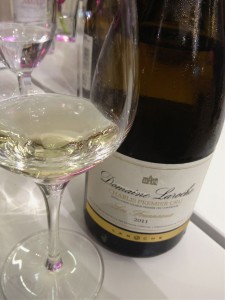Tasting Michel Laroche Chablis
September 9, 2013
By Panos Kakaviatos
Well, now, I have finally found some time to continue with wines I had tasted way back in … June this year during Vinexpo. Not too worried about this posting because it is about Chablis. One of the most underrated wines in the world. And versatile. You can enjoy Chablis anytime of the year. With food or without. I love it with oysters. And seafood in general. Or just when I want to enjoy a crisp white on its own. Chablis is the ticket.
And it comes from an exceptional terroir. As you can read from my article in France Today from 2009, the top crus of Chablis are much less expensive than the great white Burgundies of the Cote d’Or. Keep that in mind the next time you look for a dry white with nuance and depth.
Charmingly and easily pronounced, Chablis has been taken in vain internationally—again, like Champagne—and used for Australian, Spanish, California and other wines that have nothing whatsoever to do with the 11,000 acres of vineyards surrounding the tiny village of Chablis, in the Yonne département of northern Burgundy, just a 90-minute drive south of Paris. These count among France’s oldest vineyards—Cistercian monks made wine in the Chablis area as early as the 12th century. The territory’s association with Burgundy was cemented during the Middle Ages, when the sinewy Serein river formed the boundary between lands owned by the Dukes of Burgundy and the Counts of Champagne. By the late 15th century, the Duchy of Burgundy took full control of Chablis.
The best way to survey Chablis is from a vantage point above the slopes of its seven grand cru vineyards on the north side of the Serein, facing the town just across the river. While having a picnic for example on a sunny late summer day. Not that I am there now as I write this text… But a dear friend and his wife is, and I recommended they do just that. The 260 acres here offer a mix of limestone, clay, cool climate and exposure to the sun that is ideal for making great wine, even in difficult years, and the wines they produce were officially classified as grands crus in 1938: Blanchots (photo below), Preuses, Bougros, Grenouilles, Valmur, Vaudésir and—the largest in area at 61 acres—Les Clos.
The soil in Champagne consists of a basin of limestone marl known as the Kimmeridgian Ridge that starts in England and runs down through the vineyards of Champagne, and through to Burgundy – most prominently in nearby Chablis. People identified this gray colored limestone-based soil in Kimmeridge, England, where it gets its name. A mix of limestone clay and prehistoric shellfish fossils that had been deposited millions of years ago, when the surface was underwater, it contains just the right amount of clay to convey a thirst quenching mineral character. Substratum clay preserves enough water. The best wines from this soil are pristine, mineral driven and with excellent vivacity. The best Chablis (and Champagnes) can be described in similar manners even though one has bubbles and the other not.
Although Spring frosts have come less frequently in recent years, they remain a risk for Chablis. For that reason, vintners prune their vines twice, in order to prevent early bud burst that would expose vines to April frosts. Still, the region seldom suffers from excess heat so climate change is not as much a factor in Chablis as, say, in the Côte de Beaune.
Many thanks to Sandrine Audegond of Domaine Michel Laroche for guiding me through a tasting of very fine Chablis produced by Michel Laroche over lunch at the AdVini booth in Hall One during Vinexpo.
The domain dates back to the mid 19th century, but Michel Laroche expanded it from six to 100 hectares in about 10 years, after arriving to the domain in 1967.
The vines from this domain are spread out across all the denominations of the Chablisian vineyards and benefit from the Kimmeridgian soil to produce precise, refreshing and elegant wines. The domain makes wine from seven premiers cru and three grands crus terroirs.
Their Domaine Laroche Chablis St Martin 2011 I tried was very tasty. Made from a blend of wines coming from the domain’s 90 hectares in Chablis. Fermented in stainless steel, and matured on lees without oak aging. The name comes from the crypt of l’Obédiencerie (main office of Domaine Laroche), just near the church of Chablis. Transparent golden green color. Nose is subtle and conveys a mineral aspect that makes Chablis so very appealing. Palate is very stony, with a bit of gunflint. Long and gentle finish. Good one, tasty.
Domaine Laroche Chablis Premier Cru Les Fourneaux 2011. Rich and robust, a fine showing for the vintage, which proved rather challenging with a hot Spring, a Summer marked by a rather cold and rainy August although September proved fine and dry.
Domaine Laroche Chablis Premier Cru les Fourchaumes 2008. Made from old vines (45 year average), this wine conveys a pleasingly complex nose of hay, flowers and white pepper. The palate has aniseed and licorice but is not evidently expressive, but of a finer breed than Les Fourneaux, which may be more accessible at this stage nonetheless.
Domaine Laroche Chablis Les Clos Grand Cru 2011. Just 1 hectare. Very lovely here, I get aniseed coming from a fine limestone terroir and 35-year-old vines. A somewhat contained sumptuousness on the nose. More expressive on the palate, with aniseed again and a pleasingly lingering finish.
Domaine Laroche Chablis Les Blanchots Grand Cru 2008 is really delicious. White flowers and freshly cut grass.



[…] La Chapelle / Most memorable tasting of rare 2011 Quinta do Noval, Nacional Vintage Port / Fine Chablis from Michel Laroche / Added notes to Bordeaux 2010 en primeur / And […]